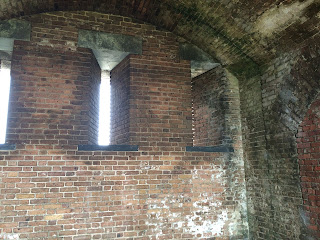We have been eager to visit the Dry Tortugas, which are almost 70 miles Southwest of Key West. We opted for a float plane, a 1960 de Havilland Otter. The flight is much shorter than the usual ferry trip, allowing us to send Max to daycare and avoid an overnight boarding.
As it turns out the flight itself was fun, providing a view of the reefs, a couple of wrecks and also numerous swimming sea turtles. Our pilot, Evan, has an interesting gypsy float plane pilot history, from Montana, to Southeast Alaska, Lake Charles, Savannah and now Key West.
 |
| Evan Flying the Otter Barefoot |
Construction of Fort Jefferson was started in 1846 for the purpose of controlling navigation to the Gulf of Mexico and protect Atlantic bound Mississippi River trade. The fort is one of the nation's largest masonry 1800's forts and when construction was stopped, it consisted of about 16 million bricks.
 |
| Sea Routes Protected by Fort Jefferson |
The fort is now part of the seven island Dry Tortugas National Park and in addition to the Fort, is noted for bird and marine life as well as shipwrecks. The islands were first named Las Tortugas by Ponce de Leon, then later shown on mariners' charts as Dry Tortugas to indicate no fresh water was available.
 |
Fort Jefferson with Surrounded by Moat
|
 |
| Building used to heat cannonballs for 30 minutes so they would set wooden ships afire |
During the Civil War the Fort was used to house captured deserters. It also housed the men convicted of complicity in Lincoln's assassination, including Samuel Mudd. Mudd had treated John Wilkes Booth and delayed reporting his presence for a day. When the prison doctor died during a yellow fever outbreak at the fort, Mudd volunteered to take his place and according to reports, heroically worked to save lives. In recognition of this he was pardoned in 1869 by President Andrew Johnson.
 |
| Dr. Samuel Mudd's Cell |
 |
| Parade Ground seen from interior fort window |
The Crane Point Museum and Nature Center is a local Key Marathon attraction, easy to get to but delightful. We took the 1 1/2 hours tram tour the morning following some heavy rain so had the tram to ourselves. The guide was delightful, though a volunteer he was a trained biologist who could identify all the plants in what is one of the few remaining hardwood hammocks.
 |
| Osprey Nest in the Hammock |
Of special importance is the hand built home of the original owner of the property, a Bahamian man who had saved $100 from his work in pineapple fields and bought the 63 acre plot sight unseen. He and his wife built the small home from tabby, which is sea shells burned to create limestone and then used to make a crude cement like material. The building stands today, more that a century later while another home on the property, the Crane house-built in 1954 by a famous architect-is unsafe for entry.
 |
| Adderly House made of Tabby |
George Adderly and his wife were hardworking entrepreneurs, making a living from collecting and cleaning sponges and making charcoal while clearing land for building and access.
After the tram tour we were able to return with Max and spend another hour walking the trails.
On a lighter note, I am on a mission to find the best Key Lime Pie. They come in many varieties and locals will argue about which is the authentic recipe. All seem to have, of course, key lime juice (it must be key limes which are tarter than other limes) and sweetened condensed milk, with graham cracker crusts. Some use eggs, cooked or uncooked, and some are topped with meringue, others whipped cream. One touted by a local general store was from The Key Lime Pie Company located in Key West. It is sold frozen and has a chiffon consistency. If you don't want the whole pie, you can buy a piece of pie on a stick, dipped in chocolate. Wonder if they have these in heaven????
 |
| Key Lime Pie with Meringue from Herbies |
 |
| Pieces of this are in the freezer, not to last long |
 |
| Key Lime Pie on a Stick |















Joan,
ReplyDeleteGlad you are having a good time. I am proud of your noble efforts to find the best key lime pie.
Even as an armchair traveler, your adventures are not just interesting, but mildly exhausting.
Mark G.